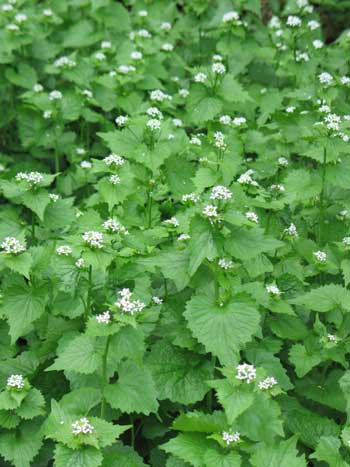Alliaria petiolata
Garlic Mustard
Synonym(s): Alliaria officinalis
Family: Brassicaceae
Duration and Habit: Cool season biennial herb

Photographer: Olivia Kwong, Plant Conservation Alliance, Washington, DC
Source: http://www.nps.gov/plants/alien/fact/alpe1.htm
Description
Garlic mustard (Alliaria petiolata) is a biennial herb characterized by green heart shaped leaves that release a garlic odor when crushed. Like many native plants garlic mustard has a white flower that can grow 2-3 ft tall with 4 petal flowers in a cluster of blossoms forming a cross shape. Garlic mustard remains green during winter months and flowers in the spring. When the plant dies in June, it can be distinguished from similar native plants by stalks of dry, brown, erect seed pods only found on garlic mustard plants. The seed pods remain viable through the summer months.
Ecological Threat: Like many invasive plants, garlic mustard is a threat to native plant species because it is aggressive and out-competes native plants for life sustaining resources. In many areas where garlic mustard has been observed, a large decrease in native wild flowers and other mustard plants occurred in addition to a decline in insect populations. The endangered butterfly, Pieris virginiensis is of particular concern because it utilizes plants that are being out-competed by garlic mustard. Pieris virginiensis is not able to lay its eggs on garlic mustard as a replacement due a toxin secreted by the plant that kills emerging caterpillars.
Biology & Spread: One garlic mustard plant is capable of producing thousands of seeds that disperse several feet away from the parent plant. Seed dispersal is believed to be human or wildlife assisted because the seeds do not float or travel by air very easily. Once in the soil, seeds can remain viable for up to 5 years. Fertilization of garlic mustard can be self-fertilization or pollination from insect pollinators. Self-fertilization produces a clone (exact copy) of the parent plant allowing for a more rapid establishment in a new area.
History: The first record of garlic mustard in the United States was in 1868 in Long Island, NY. The plant was most likely brought to the United States for food and medicinal reasons.
Habitat: Disturbed areas such as roadsides are the most common habitat invaded by the garlic mustard plant. It can also be found in moist shaded areas such as river floodplains (providing adequate shade), forests, forest openings, and along trails. Garlic mustard can't grow in conditions of high acidity, but can tolerate varying amounts of water or sunlight.
Distribution
Native Origin: Europe
U.S. Present: AK, CT, DC, DE, GA, IA, IL, IN, KY, MA, MD, ME, MI, MO, NC, NH, NJ, NY, OH, OR, PA, TN, VA, VT, WI, WV
To view a distribution map provided by EDDmapS click here.
Management
Small infestations of garlic mustard can be treated by hand pulling the plant with special care to ensure the entire root system is removed. This method is effective when native plants are growing closely to garlic mustard plants. Slightly larger infestations can be treated by cutting the plant an inch from the ground preventing seed production in early summer. For large infestations of garlic mustard, where native plants are not present in high densities, herbicides containing glycophosphate can be used to eradicate plants. Consistent application of herbicides are necessary to effectively stop garlic mustard invasions and can be done throughout the year with temperatures above 50o F and no chance of rain for 8 hours. Prescribed burning can be used, but only when native plants are in low densities among the garlic mustard plants.
Text References
Abugatta, Alonso. 1996. Progress made in educating about problems with invasive plants. Virginia Native Plant Society Newsletter, Vol. 15, No. 3, (May) p. 5.
Byers, D. L., & Quinn, J. A. 1998. Demographic variation in Alliaria petiolata (Brassicaceae) in four contrasting habitats. Journal of the Torrey Botanical Society, 138-149.
Nuzzo, V.A. 1991. Experimental Control of garlic mustard in Northern Illinois using fire, herbicide, and cutting. Natural Areas Journal 11(3):158-167.
.
Internet Sources
http://www.invasive.org/weedus/index.html
http://www.invasivespeciesinfo.gov
 Texas Invasive Species Institute
Texas Invasive Species Institute